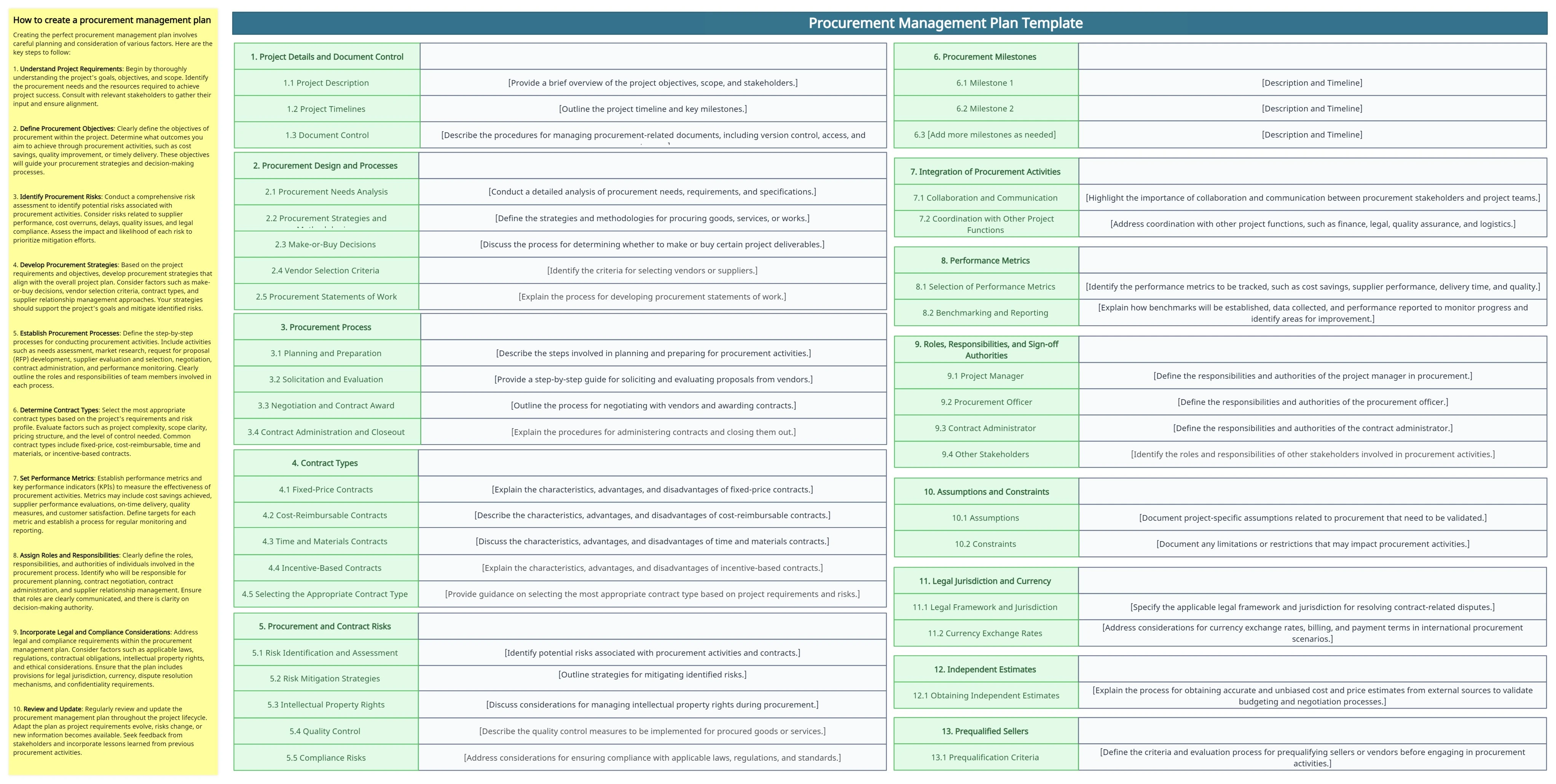Procurement management is crucial for project success. Whether you’re an experienced pro or just starting out in project management, having a solid procurement plan is key. A well-crafted procurement plan helps you control costs, minimize risks, and maintain a good relationship with your suppliers. Plus, it establishes clear communication channels and effectively allocates your project resources.
In this article, we’ll explore the importance of a procurement management plan and introduce a comprehensive template for improving procurement success. We’ll discuss the template’s components, and key considerations, and provide practical insights on leveraging it effectively. Keep reading.
- What is a Procurement Management Plan?
- Importance of a Well-Defined Procurement Management Plan
- Components of a Procurement Management Plan Template
- How to Create a Procurement Management Plan
- When to Use a Procurement Management Plan
What is a Procurement Management Plan?
A procurement management plan is a comprehensive document that outlines the strategies, procedures, and guidelines for managing procurement activities within a project. It serves as a roadmap for procurement processes, ensuring that the right resources are acquired at the right time and cost. The plan is developed by the project manager in collaboration with relevant stakeholders and is an integral part of the overall project management framework.
The primary purpose of a procurement management plan is to provide a structured approach to procurement activities, from identifying procurement needs to contract administration and closeout. It serves as a central reference document for the project team, providing clarity on how procurement processes should be conducted, who is responsible for each task, and what procedures should be followed.
Importance of a Well-Defined Procurement Management Plan
A well-defined procurement management plan is essential for ensuring successful procurement outcomes within a project. Here are several key reasons why a plan is crucial.
1. Streamlined Processes: The plan establishes a standardized approach, reducing errors and delays in procurement activities.
2. Clear Roles and Responsibilities: Clearly defined roles promote accountability and effective collaboration among stakeholders.
3. Risk Mitigation: The plan includes strategies to identify and manage procurement risks, ensuring proactive risk mitigation.
4. Cost Control: Effective procurement management controls project costs through estimation, budgeting, and monitoring.
5. Compliance and Legal Considerations: The plan addresses legal requirements, and facilitating contract compliance.
6. Stakeholder Satisfaction: Successful procurement meets project requirements, enhancing stakeholder confidence and project outcomes.
Components of a Procurement Management Plan Template
A procurement management plan Template consists of several key components that provide a comprehensive framework for managing procurement activities within a project. Below are the key elements of a procurement management plan template.

Project Details and Document Control
This section of the template captures essential information about the project, including the project name, description, objectives, stakeholders, and timelines. It serves as a reference point for understanding the context and scope of procurement activities within the project. Additionally, document control procedures are outlined to ensure proper management of procurement-related documents, such as contracts, proposals, and correspondence.
Procurement Design and Processes
In this section, the template focuses on the design phase of procurement. It includes a detailed analysis of procurement needs, requirements, and specifications. It outlines the strategies and methodologies to be employed for procuring goods, services, or works. The section may also cover make-or-buy decisions, vendor selection criteria, and the process of developing procurement statements of work.
Procurement Process
The procurement process section provides a step-by-step guide to executing procurement activities within the project. It encompasses planning and preparation, solicitation and evaluation of proposals, negotiation, and contract award, and contract administration and closeout. Each step is described in detail, including the necessary documentation, timelines, and key considerations.
Contract Types
This section explains various types of contracts that may be employed in procurement. It outlines the characteristics, advantages, and disadvantages of contract types such as fixed-price, cost-reimbursable, time and materials, and incentive-based contracts. This helps project teams select the most appropriate contract type based on project requirements, risks, and the nature of the deliverables.
Procurement and Contract Risks
Risk management is crucial in procurement. This section focuses on identifying and assessing potential risks associated with procurement activities and contracts. It provides guidance on developing risk mitigation strategies, contingency plans, and monitoring mechanisms to address these risks effectively. The section may also include considerations for managing intellectual property rights, quality control, and compliance risks.
Procurement Milestones
Procurement milestones are key events or deliverables that mark significant progress in the procurement process. This section outlines the important milestones throughout the procurement lifecycle, such as the completion of procurement planning, issuance of requests for proposals, evaluation, and selection of vendors, contract award, and contract closeout. Clear milestones help track progress, facilitate communication, and ensure the timely completion of procurement activities.
Integration of Procurement Activities
This section emphasizes the integration of procurement activities with other project management processes. It highlights the importance of collaboration and communication between procurement stakeholders and project teams. Integration of procurement activities addresses coordination with other project functions, such as finance, legal, quality assurance, and logistics, to ensure seamless integration and alignment of procurement efforts with the overall project objectives.
Performance Metrics
Performance metrics are essential for evaluating the effectiveness and efficiency of procurement activities. This section discusses the selection and tracking of metrics, such as cost savings, supplier performance, delivery time, and quality. It provides guidance on establishing benchmarks, collecting data, analyzing performance, and reporting on key procurement metrics to monitor progress and identify areas for improvement.
Roles, Responsibilities, and Sign-off Authorities
This section defines the roles, responsibilities, and authorities of individuals involved in the procurement process. It clearly outlines the duties of project managers, procurement officers, contract administrators, and other stakeholders. It helps ensure accountability, clarity, and effective decision-making by assigning specific responsibilities and sign-off authorities at various stages of the procurement lifecycle.
Assumptions and Constraints
In this section, project-specific assumptions and constraints related to procurement are documented. Assumptions are factors or conditions that are considered to be true but are not yet validated. Constraints are limitations or restrictions that may impact procurement activities. Identifying and documenting these assumptions and constraints help stakeholders understand the context and potential limitations of procurement planning and execution.
Legal Jurisdiction and Currency
This section addresses legal and jurisdictional considerations in procurement contracts. It specifies the applicable legal framework and jurisdiction for resolving contract-related disputes. It also outlines considerations for currency exchange rates, billing, and payment terms in international procurement scenarios. Compliance with legal requirements is crucial to ensure contractual validity and mitigate legal risks.
Independent Estimates
This section emphasizes the importance of independent cost and price estimates in procurement. It provides guidance on obtaining accurate and unbiased estimates from external sources to validate budgeting and negotiation processes. Independent estimates serve as benchmarks for evaluating vendor proposals, ensuring fair and competitive pricing, and minimizing the risk of cost overruns or inflated pricing.
Prequalified Sellers
This section focuses on the process of prequalifying sellers or vendors before engaging in procurement activities. It outlines the criteria, evaluation process, and registration requirements for prequalification. Prequalifying sellers ensures that only qualified and reliable vendors are invited to participate in procurement processes, reducing the risk of selecting unqualified or non-performing suppliers.
How to Create a Procurement Management Plan
Creating the perfect procurement management plan involves careful planning and consideration of various factors. Here are the key steps to follow:
1. Understand Project Requirements: Thoroughly grasp project goals and stakeholder input to identify procurement needs and necessary resources.
2. Define Procurement Objectives: Clearly establish procurement objectives aligned with project goals, such as cost savings or quality improvement.
3. Identify Procurement Risks: Conduct a comprehensive risk assessment to identify potential risks and prioritize mitigation efforts.
4. Develop Procurement Strategies: Create strategies that align with project goals, considering factors like vendor selection and risk mitigation.
5. Establish Procurement Processes: Define step-by-step processes, outlining roles and responsibilities for needs assessment, negotiation, and performance monitoring.
6. Determine Contract Types: Select suitable contract types based on project requirements, complexity, and desired control.
7. Set Performance Metrics: Define metrics and KPIs to measure procurement effectiveness, such as cost savings and on-time delivery.
8. Assign Roles and Responsibilities: Clearly define roles and authorities for procurement planning, negotiation, and contract administration.
9. Incorporate Legal and Compliance Considerations: Address legal requirements, regulations, and ethical considerations in the procurement plan.
10. Review and Update: Regularly review and update the plan to adapt to evolving project needs, risks, and stakeholder feedback.
Interesting Read: Stakeholder Management Plan Templates
When to Use a Procurement Management Plan
A procurement management plan should be used in any project that involves the acquisition of goods, services, or works from external sources. Here are some scenarios where a procurement management plan is essential:
1. Complex Projects: Projects with high complexity, large budgets, and multiple stakeholders often require a procurement management plan. It helps ensure proper planning, coordination, and execution of procurement activities to meet project objectives effectively.
2. Resource-intensive Projects: Projects that heavily rely on external resources, such as materials, equipment, or specialized services, require a procurement management plan. It enables efficient allocation and acquisition of resources to support project execution.
3. Regulatory Compliance: When projects must adhere to specific legal or regulatory requirements, a procurement management plan becomes crucial. It ensures compliance with applicable laws, regulations, and policies throughout the procurement process.
4. Risk Mitigation: Projects with significant procurement-related risks, such as supplier non-performance, cost overruns, or delays, benefit from a procurement management plan. It helps identify, assess, and mitigate risks associated with procurement activities, minimizing their impact on the project.
5. Cost Control: A procurement management plan is essential for projects with strict budget constraints. It provides mechanisms to control costs, negotiate favorable contracts, and monitor expenses throughout the procurement lifecycle.
6. Strategic Procurement: Projects that prioritize strategic procurement, such as sourcing innovative solutions, establishing long-term partnerships, or leveraging market opportunities, require a procurement management plan. It guides the strategic decision-making process and ensures alignment with project goals.
7. Collaboration with Multiple Stakeholders: Projects involving collaborations with multiple stakeholders, including suppliers, contractors, or subcontractors, benefit from a procurement management plan. It facilitates effective communication, coordination, and integration of procurement activities across different parties.
8. International Projects: When projects involve cross-border procurement, including global suppliers or multiple currencies, a procurement management plan is essential. It addresses international legal considerations, currency exchange, and cultural factors impacting procurement processes.
9. Project Continuity: A procurement management plan ensures continuity in procurement activities, even if there are changes in project team members or leadership. It provides a standardized approach that can be followed consistently throughout the project’s duration.
10. Best Practices Implementation: Organizations aiming to establish consistent and best practices in procurement can benefit from a procurement management plan. It serves as a framework for implementing standardized processes, roles, and responsibilities across projects.
Conclusion
Developing and implementing a well-structured procurement management plan is essential for ensuring the success of procurement activities within your project. By utilizing the comprehensive procurement management plan template provided, you can streamline processes, mitigate risks, and maximize value delivery to stakeholders. Each section of the template, from project details and document control to performance metrics and prequalified sellers, plays a crucial role in optimizing your procurement outcomes.
With this template as your guide, you have the tools and framework to enhance your project’s procurement success. Customize the template to align with your project’s unique needs and requirements. By doing so, you can create a tailored procurement management plan that will effectively manage procurement processes, control costs, and minimize risks.


![What is a Project Initiation Document (PID)? [with Free Template]](/static/assets/guides/project-initiation-document-explained/hero.webp)


